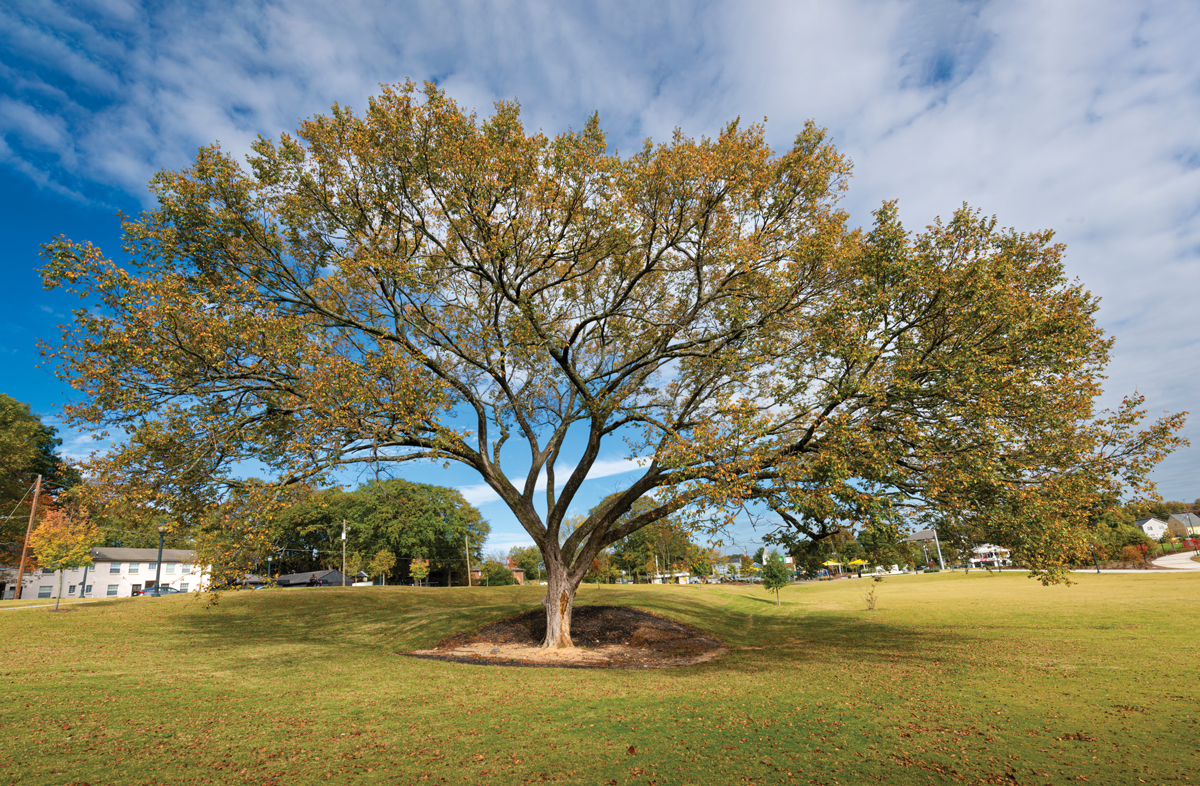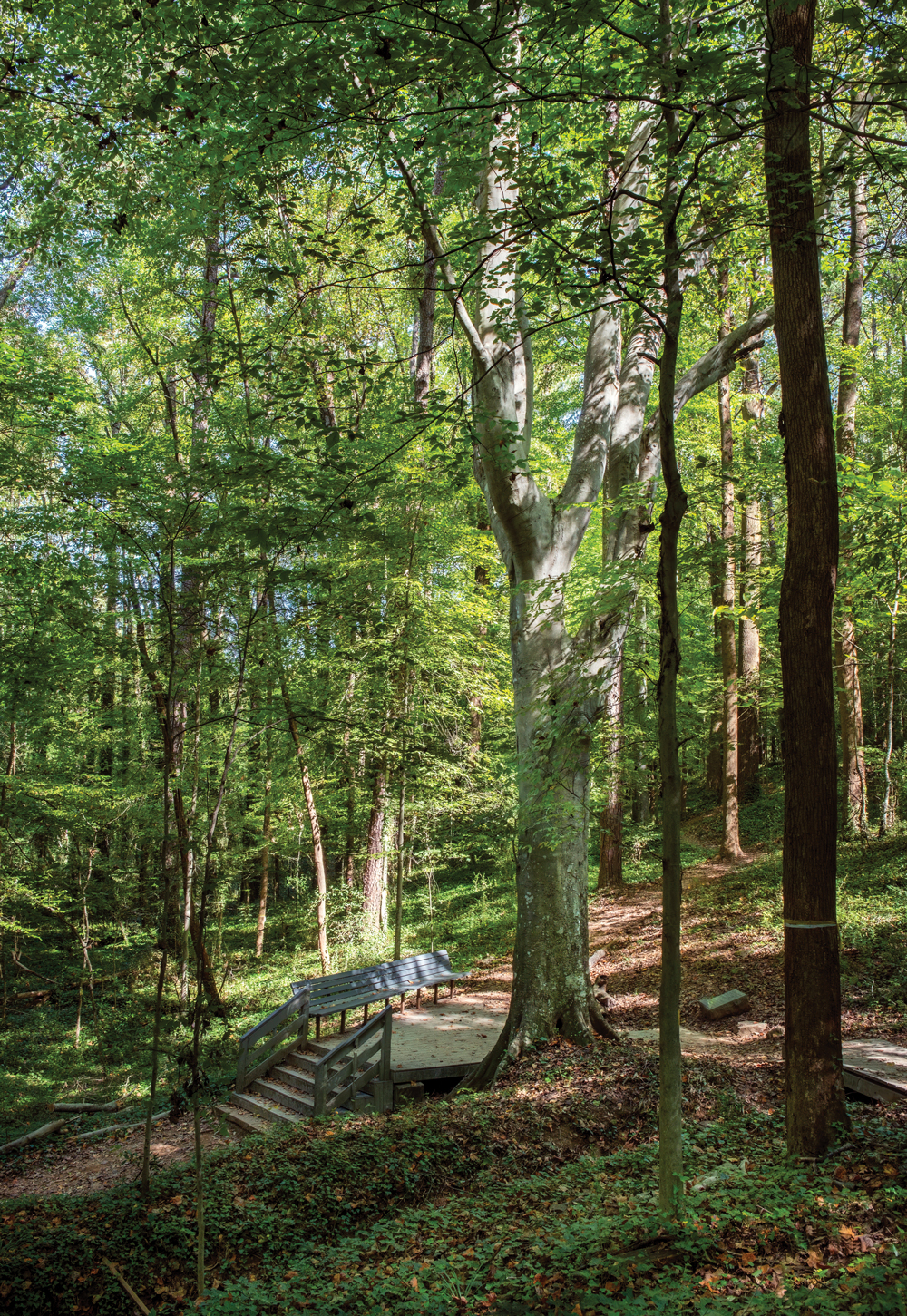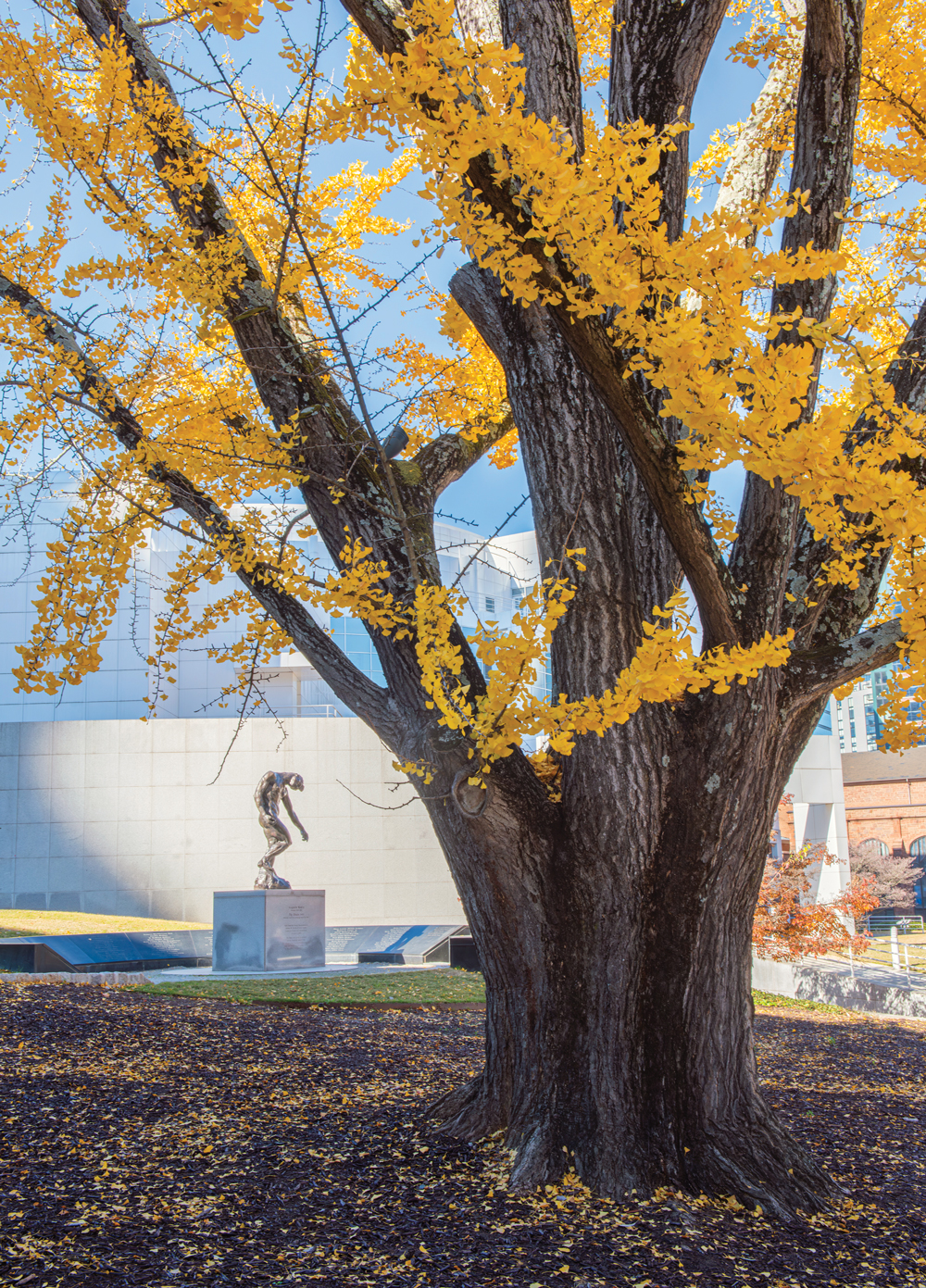

Photograph by Virginie Kippelen
Incense Cedar
(Libocedrus decurrens)
Agnes Scott College
Circ: 93.7”
Height: 71.9’
Canopy spread: 30’
Rank: 1
Points: 173.1
Public access
This tree, native to California, is the only one of its kind known to exist in the Atlanta area. Nobody knows exactly how the “mystery incense cedar” got here, nor who planted it, more than 180 years ago—decades before the Civil War.
In a culture obsessed with competition, it comes as no surprise that even our trees have been put to the test. In 1940, the organization American Forests, in an effort to boost public interest in its field, began searching the nation for the largest specimen of each tree species. This project launched the National Champion Tree program, an exclusive honor bestowed upon the United States’ largest trees. States and cities soon followed with initiatives to reward their own tallest and widest living residents.
Nationwide, only one Georgia tree has managed to crack the top 500: a live oak in Clarke County that also holds the record for largest crown, spreading a whopping half an acre at its top. But Atlanta—home to the highest percentage of urban tree canopy in the nation—keeps its own tally of local champions. The nonprofit Park Pride began the Atlanta Champion Trees list in the 1990s; it’s now maintained by Trees Atlanta, which relies on staff and volunteers to monitor existing winners and evaluate new candidates. More than 300 trees, covering 120 species, have made the list. More are nominated every year: Trees Atlanta announces the newcomers at its annual Georgia Arbor Day celebration in February.
To separate the champions from the merely large, arborists rely on a point system based on a tree’s circumference, height, and canopy spread. One point is awarded per inch circumference, one point per foot in height, and a quarter point for every foot in average crown spread. Each species is ranked separately, so that a squat spicebush (Atlanta Champion, 21 feet tall) is not measured against a towering basswood (Atlanta Champion, 132 feet tall).
Though many champion trees have been standing for decades or even centuries, they are not necessarily the city’s oldest trees. “It does not mean prettiest. It does not mean it has historical significance,” says Eli Dickerson, director of education at Park Pride and a longtime investigator for the program. “It simply means, by these three measurements and this point system, it has the most points.”
Champion trees don’t revel in glory forever. A tree can lose its champion status when a larger specimen is discovered, knocking it from the list. A significant number of winning trees die every year, from old age or, sadly, human intervention; champion status does not give these trees any additional legal protection.
In honor of Earth Month, celebrated every April, this series documents a handful of Atlanta’s champion trees—just some of the towering neighbors with whom we share our city. Many of these trees are true survivalists, hanging on amid the inhospitable conditions of an ever-expanding city. They live astride busy roads, like the ginkgo in front of the High Museum of Art, or tucked between houses in dense neighborhoods, in the case of the champion tupelo. Their size makes them notable, but they are perhaps most remarkable simply because they have stayed alive.
“Atlanta has grown and changed during the time these trees have grown,” says Alex Beasley, Trees Atlanta’s director of planting. “Their survival highlights the inherent resilience of nature.”

Photograph by Virginie Kippelen
American elm
(Ulmus americana)
641 Thurmond Street NW
Circ: 150”
Height: 65’
Canopy Spread: 110’
Rank: 1
Points: 242.5
Public access
Elms were once some of the most common trees across the eastern United States, but in the mid-20th century the population was decimated by Dutch elm disease. This glorious specimen sits on a gentle hill in the Vine City neighborhood. During park construction in 2017, it received important protective treatment thanks to its champion status to ensure it was saved.

Photograph by Virginie Kippelen
White ash
(Fraxinus americana)
Louise G. Howard Park
Circ: 171.6”
Height: 129’
Canopy spread: 56.3’
Rank: 1
Points: 314.7
Public access
This tree is one of Atlanta’s few champions that also holds the title statewide. Common white ash is known as “poor man’s oak” since it can be substituted for the more expensive hardwood. This particular tree is distinctively massive for its species. It can be seen leaning over the paved path parallel to Tanyard Creek. Because it’s suffered lightning strikes and been besieged by invasive emerald ash borer insects, arborists worry it may not be around much longer.

Photograph by Virginie Kippelen
Beech
(Fagus grandifolia)
West Atlanta Watershed Alliance Outdoor Activity Center
Circ: 136”
Height: 120.5’
Canopy spread: 90’
Rank: 3
Points: 279
Public access
Also known as the “Grandfather Beech Tree,” this specimen dates back to 1863. A platform and a bench allow visitors to contemplate its towering limbs and smooth, silvery-gray bark. Its longevity may be aided by its proximity to many other mature trees in this 26-acre nature preserve, which features one of the few old-growth forest remnants in Atlanta.

Photograph by Virginie Kippelen
Southern Magnolia
(Magnolia grandiflora)
Decatur Recreation Center
There is no lack of champion Southern magnolias within Atlanta’s perimeter. Even if the grandiflora species is not native to the Piedmont forest, it remains an enduring local favorite. This tree, located near the Decatur library, is a new contender to join the list of Atlanta’s champion magnolias; arborists will take careful measurements and determine its status later this year. Its distinctive low branches have hosted generations of climbing children.

Photograph by Virginie Kippelen
Cherrybark oak
(Quercus pagoda)
Our Lady of Perpetual Hope Cancer Home
Circ: 276”
Height: 102’
Canopy spread: 130’
Rank: 1
Points: 410.5
Public access with permission from the hopsice
The Dominican nuns who run this hospice home for terminally ill cancer patients have lavished this tree with care, and it thrives today. The hospice, constructed in the 1970s, was built around the tree in an L-shape, allowing residents to enjoy it from their windows. It is one of the largest measured trees in Atlanta.

Photograph by Virginie Kippelen
Swamp titi
(Cyrilla racemiflora)
Fernbank Science Center
Circ: 30”
Height: 12’
Canopy spread: 24’
Rank: 1
Points: 48
Public access
This titi swarms with pollinators in spring and summer. It’s thought to have been planted on a whim by a Fernbank horticulturist when the center opened in 1967. Thirty years ago, staff members were removing invasive plants from the front yard when they discovered the tree, which had been dwarfed by larger neighbors for years. It is now part of Fernbank’s climate-resilient demonstration garden, which highlights plants native to the Southeast for ecological conservation.

Photograph by Virginie Kippelen
Black tupelo
(black gum) (Nyssa sylvatica)
622 Moreland Avenue NE
Circ: 110”
Height: 90’
Canopy spread: 45’
Rank: 2
Points: 211.3
Private residence
This black tupelo, in a private yard in Poncey-Highland, is flanked by houses but is visible from the street. Relatively small compared to other trees, it is huge for its species. “I crazy love this tree,” says Greg Levine, executive director at Trees Atlanta. “It has been on our list for almost two decades and it still stands tall and has beautiful fall colors.”

Photograph by Virginie Kippelen
Sugarberry
(Celtis laevigata)
The Children’s School
Circ: 203”
Height: 71’
Canopy spread: 106’
Rank: 1
Points: 300.5
Private property
“This sugarberry is exceptionally large for its species and likely survived as a boundary tree along a now-abandoned alley,” says Anna Hauser, an arborist and parent of a Children’s School student, who nominated the sugarberry. With a canopy spread of 106 feet, it is 7 feet wider than the current national champion, making it a contender for a bigger award.

Photograph by Virginie Kippelen
Ginkgo
(Ginkgo biloba)
High Museum of Art
Circ: 186”
Height: 90.2’
Canopy spread: 86’
Rank: 1
Points: 297.7
Public access
This ginkgo is a crowd-pleaser for museumgoers and passersby alike, especially in the fall, when its leaves turn a Van Gogh–worthy yellow. Nearby renovations, pollution, and urban life have stressed its health for decades, but it is still standing.
This article appears in our April 2025 issue.
Advertisement







